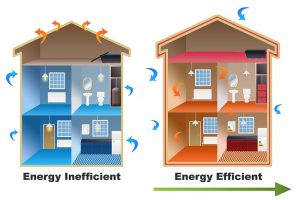
An Energy Performance Certificate, or EPC, shows how energy efficient a property is, as well as how energy efficient it could be. The certificate contains a lot of information on how a property can be improved and how you can go about doing this. Here are some things you can learn from your EPC.
Energy Efficiency Rating
The Energy Efficiency Rating shows how efficient the property was at the time the certificate was issued. You’ll see a rating somewhere between A and G. The most energy efficient home would have an A rating, whilst the worst possible score is G. The average rating for a property in England and Wales is D. The higher the rating, the lower your fuel bills are likely to be.
The EPC will also show you the potential Energy Efficiency Rating for the property. This shows you how much better the performance could be if you carried out all the recommended improvements (see Recommendations below).
The Energy Efficiency Rating is particularly important for landlords as you are not normally allowed to rent out a property with an F or G rating.
Estimated Energy Costs
Every EPC includes an estimate of the typical total energy bills over a three year period. And it also provides an estimate of how much lower these bills would be if you carried out the recommended improvements. These figures are broken down into three categories: lighting, heating and hot water. The figures don’t include electricity used by appliances such as TVs, cookers, computer, and they don’t include any electricity you generate if you have solar PV panels on the roof.
Summary of Energy Efficient Features
There’s a summary of the property’s key features, such as walls, roofs, floors, windows, heating, hot water and lighting. This section gives each feature a rating out of five stars, so you can easily see where there might be room for improvement.
 Recommendations
Recommendations
One of the most useful parts of an EPC is the list of recommended measures for improving energy performance. For each recommended improvement there is an average cost of installation, typical savings per year and how much the energy rating of the property will be improved by having each measure installed.
The EPC also recommends alternative measures that could be considered for the property. This often contains renewable alternatives such as heat pumps or biomass boilers.
There’s also a ‘top actions’ section which ranks the recommendations by cost-effectiveness.
Environmental Impact of the Property
You can found out how well your home ranks in terms of environmental impact. There’s another rating that shows how well the building is likely to perform in terms of carbon dioxide (CO2) emissions. Once again the best is A and the worst is G. The EPC shows the current rating of the property alongside a potential rating which can be achieved by installing the measures recommended in the previous section.
Heat Demand
The heat demand of the property (in kilowatt-hours) is shown for both space heating and water heating. And there’s a table showing how this demand would be affected by fitting loft or wall insulation.
What an EPC doesn’t tell you
An EPC is a snapshot in time. If you’ve had work carried out in your home since the EPC was produced, then this won’t show up. Recent improvements will only be taken into account if you get an assessor to produce a new EPC for you.
An EPC is also not about you and your family – it’s about the building. If you live a low energy lifestyle – turning everything off, buying efficient appliances and managing the heating controls carefully, then that’s great, but your EPC won’t show it. This is because the point of the EPC is to show new owners and occupiers what they can expect if they take the property on. So it only includes those energy factors that will be passed in when the property is sold, or rented to a new tenant.
What does an EPC survey involve?
If you’re in a hurry to get your house sold fast, you might be concerned that acquiring an EPC is a lengthy process, but in most cases, it’s not. If you have a standard domestic property with less than 6 bedrooms, the initial EPC visit should take no longer than 45 mins. A lot of places will offer 24-hour turnaround on their EPC paperwork, meaning you could get the appropriate energy performance certificate officially lodged within a day.
The visit itself involves gathering information about various aspects of the property. This includes the boiler, the insulation, the windows, the central heating system, any hot water tanks. The assessor will make a rudimentary floorplan and take pictures as they work, in order to provide the evidence necessary to lodge the certificate.
EPC surveys are non-invasive. That means that if you have loft insulation, for example, the surveyor must be able to easily get up there to see in order to lodge it. They cannot take your word for it, and they can’t make boreholes to check for cavity wall insulation or cause any damage. If you have any work that you think should be included on the EPC that the assessor will not be able to easily see or access, paperwork like invoices or warranties can be used to prove the existence of it and get it included on the survey.
